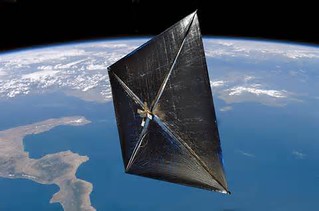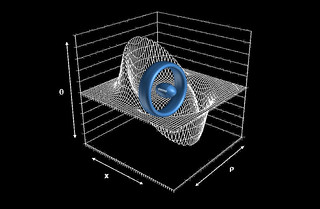This week I will continue with my examination of space travel technology, focusing on propulsion; but this time looking at the less commonly discussed and written about technologies. Again, I remind you, reader, that I want only to help understand current theory – perhaps open some doors – not quash your imagination.
Solar Sail Propulsion

As a sailboat enthusiast from way back I know well the elegance and economies of using wind to power a craft. But light? Yes.
The idea of powering spacecraft with sails harnessing the “solar wind” was first proposed by Johannes Kepler who observed that comet tails point away from the Sun and suggested that the sun caused this effect. In a letter to Galileo in 1610, he wrote, “Provide ships or sails adapted to the heavenly breezes, and there will be some who will brave even that void.” [1]
The technical term is Solar Radiation Pressure and it is made up of photons (light) and elemental gasses. The sails must be mirror-like reflective to utilize the photon energy. Although the SRP or “Solar Wind” blows at (or near) the speed of light, its actual impetus is rather low. It will take HUGE sails to pull a space craft of any size through the heavens.
Two launch conditions are being considered both assume that the craft itself will be either boosted into orbit on a rocket or built in orbit.
The first is to unfurl the sails (see video below) and allow the Solar Radiation Pressure to do a slow-but-steady push on the sails. The craft will pick up speed as the SRP continues to “blow” against it. But, high speeds would probably not develop before the craft is so far away from the sun that the push it gets is diminished. Best speed with this is estimated to be 90 km per second (km/s). A modification of this is to use microwave or laser emplacements to give the craft a “shove” at certain points to bring the speed up to 30,000 km/s (1/10 the speed of light) and bring interstellar travel into the realm of possibility.
The second is to allow the craft to fall toward the sun, with its sails angled to a passive state, and perform a slingshot around the sun; swinging the sails into full-on position as it begins departure from the sun. Computer models of this technique show that speeds of 480,000 km/s could be attained as a departure speed. [2]
Fanciful wishing? Not at all; indeed, NASA has already accomplished a test flight with its NanoSail-D and the Planetary Society, a privately owned foundation, is constructing a model of its own; the Cosmos 1, which boasts solar sails that are made of aluminum-reinforced Mylar and are approximately one fourth the thickness of a one-ply plastic trash bag. Many consider this to be the best technology to carry mankind to the stars.
Discovery News:
http://news.discovery.com/videos/space-nasa-unfurls-solar-sail.html
Gravity Drive Propulsion
The so-called “hyperdrive” concept won the 2005 American Institute of Aeronautics & Astronautics award for the best nuclear and future flight paper. Among its defenders is aerospace engineer Pavlos Mikellides, from the Arizona State University in Tempe. Mikellides, who reviewed the winning paper, said: “Even though such features have been explored before, this particular approach is quite unique.”
The basic concept is this: according to the paper’s authors – Jochem Häuser, a physicist and professor of computer science at the University of Applied Sciences in Salzgitter and Walter DrÃscher, a retired Austrian patent officer – if you put a huge rotating ring above a superconducting coil and pump enough current through the coil, the resulting large magnetic field will “reduce the gravitational pull on the ring to the point where it floats free”.
The origins of this “repulsive anti-gravity force” and the hyperdrive it might power lie in the work of German scientist Burkhard Heim, who – as part of his attempts to reconcile quantum mechanics and Einstein’s general theory of relativity.
Another version of this theory is to use a spinning super-conductive ring to negate gravity and even reverse the gravitational pull to turn it into a push, similar to the way same-pole magnets behave. This one is big with conspiracy theorists who are certain the Germans actually built such a craft in WWII.
Another form of “hyperdrive” is the system that drops a spaceship out of the normal universe and allows it to somehow fly through some other layer of existence called hyperspace. So far, this is pure conjecture. Were it to be made real, it may come with an important side effect. Inside a ship traveling at or above the speed of light, time slows down. Passengers in this ship may feel as though only a few days have passed on their journey, but outside in the real universe, 1,000 years may have passed. This could make it difficult to maintain relationships back home!
Warp Drive
 In a warp drive engine you don’t depend on thrust from an engine, you “compress” space to reduce the distance being traveled. Some models then use low-powered thrusters to move the ship through the compressed space, while others depend on the “detergent effect” to push the ship along without thrusters.
In a warp drive engine you don’t depend on thrust from an engine, you “compress” space to reduce the distance being traveled. Some models then use low-powered thrusters to move the ship through the compressed space, while others depend on the “detergent effect” to push the ship along without thrusters.
A concept for a real-life warp drive was suggested in 1994 by Mexican physicist Miguel Alcubierre. Although his calculations found that such a device would require prohibitive amounts of energy, physicists now say adjustments can be made to the proposed warp drive that would enable it to run on significantly less energy. This would potentially bring the idea back from the realm of science fiction into science theory. [4]
How do we warp space? Again we’re probably dealing with superconductors (or as yet unknown exotic materials) to create super intense fields of gravity[5] to scrunch up space before the ship, expand it behind the ship and leave a space in the middle: the bubble or shell, in normal space.
Link: http://www.space.com/16413-star-trek-s-warp-drive-are-we-there-yet-video.html
Do you have a favorite exotic propulsion system? If so please share it below. Feel free to embed a URL to a resource, if it doesn’t convert to a link, I’ll do that manually.
Others in this Series:
Science Fiction Fact & Fancy: Space Travel
Science Fiction Fact & Fancy: Propulsion-Engines
Science Fiction Fact & Fancy: Propulsion-Exotic
Space: A Really Dangerous Place to Live
Science Fiction Fact & Fancy: Navigation
NASA Plans a Real Warp Drive
NASA Actually Working on a Warp Drive
World’s Largest Solar Sail, Passes Key Test For 2015 Launch (VIDEO)


6 thoughts on “Science Fiction Fact and Fancy: Propulsion-Exotic”
Comments are closed.